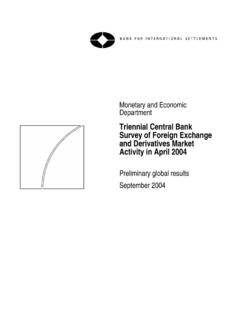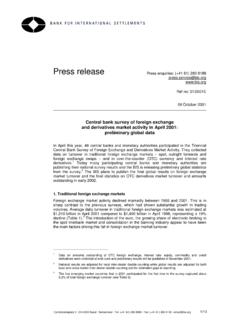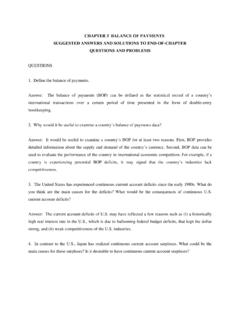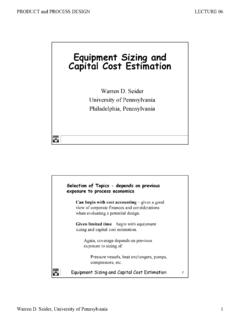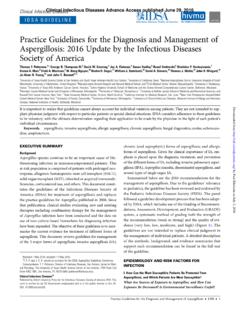Transcription of Project Finance Teaching Note
1 _____The Wharton SchoolProject Finance Teaching Note - 1 Project Finance Teaching NoteFNCE 208/731 Fall 1996 Professor Gordon M. Bodnarwritten byBruce Comer_____This Teaching note was prepared by Bruce Comer under the Guidance of Professor Gordon Bodnar and Mr. Tom Pyle of PrincetonPacific Group. This note in intended for Teaching purposes only and not for public distribution. Copyright Wharton SchoolProject Finance Teaching Note - 2I. Definition of Project financeThe term Project Finance is used loosely by academics, bankers and journalists todescribe a range of financing arrangements. Often bandied about in trade journals andindustry conferences as a new financing technique, Project Finance is actually acenturies-old financing method that predates corporate Finance . However with theexplosive growth in privately financed infrastructure projects in the developing world,the technique is enjoying renewed attention.
2 The purposes of this note are to contrastproject Finance with traditional corporate financing techniques; to highlight theadvantages and disadvantages of Project Finance and ; to propose that a single structureunderlies every Project Finance transaction; to explain the myriad of risks involved inthese transactions; and, to raise questions for future financing techniques date back to at least 1299 when the English Crownfinanced the exploration and the development of the Devon silver mines by repayingthe Florentine merchant bank, Frescobaldi, with output from the The Italianbankers held a one-year lease and mining concession, , they were entitled to as muchsilver as they could mine during the year. In this example, the chief characteristic ofthe Project financing is the use of the Project s output or assets to secure form of Project Finance was used to fund sailing ship voyages until the 17thcentury.
3 Investors would provide financing for trading expeditions on a voyage-by-voyage basis. Upon return, the cargo and ships would be liquidated and the proceedsof the voyage split amongst An individual investor then could decidewhether or not to invest in the sailing ship s next voyage, or to put the capital to otheruses. In this early example the essential aspect of Project financing is the finite life ofthe enterprise. In corporate Finance terms, we can also think of this mandatoryliquidation as a fixed dividend policy. The idea of Project Finance predated the idea ofpermanent capital entrusted to a group of professional managers who would deciderather autonomously between paying dividends and financing has evolved through the centuries into primarily a vehicle forassembling a consortium of investors, lenders and other participants to undertakeinfrastructure projects that would be too large for individual investors to more recent prominent examples of Project Finance structures facilitating projectsare the construction of the Trans-Alaskan pipeline and exploration and exploitation ofthe North Sea oil fields.
4 In the late 1990s, the technique has become rather prevalentand is frequently used to Finance independent power plants and other infrastructureprojects around the world as governments face budgetary constraints. 1 John W. Kensinger and John D. Martin. Project Finance : Raising Money the Old-Fashioned Way, inDonald H. Chew, Jr., ed. 1993. The New Corporate Finance : Where Theory Meets Practice. New York:McGraw-Hill, p. Kensinger and Martin, p. Wharton SchoolProject Finance Teaching Note - 3 There is no singular definition of Project Finance . In a article in the Harvard BusinessReview, Wynant defined Project Finance as a financing of a major independent capitalinvestment that the sponsoring company has segregated from its assets and generalpurpose obligations. 3 A major player in sponsoring infrastructure projects andproviding financing in developing countries, the World Bank defines Project Finance asthe use of nonrecourse or limited-recourse financing.
5 Further defining these twoterms, the financing of a Project is said to be nonrecourse when lenders are repaid onlyfrom the cash flow generated by the Project or, in the event of complete failure, fromthe value of the Project s assets. Lenders may also have limited recourse to the assets of aparent company sponsoring a Project . 4 These two definitions along with the historicalexamples above begin to establish the characteristics of Project Finance . In building amore robust picture of Project Finance , it is helpful to articulate the full list ofcharacteristics and to contrast Project Finance with corporate can a Project financing be identified? What details should we expect to find aboutthe transaction? Not every Project financing transaction will have every characteristic,but the following provides a preliminary list of common features of Project Project financings tend to be large-scale projects that require a greatdeal of debt and equity capital, from hundreds of millions to billions of projects tend to fill this category.
6 A World Bank study in late 1993 foundthat the average size of Project financed infrastructure projects in developing countrieswas $440 million. However, projects that were in the planning stages at that time hadan average size $710 leveraged. These transactions tend to be highly leveraged with debtaccounting for usually 65% to 80% of capital in relatively normal term. The tenor for Project financings can easily reach 15 to 20 entity with a finite life. Similar to the ancient voyage-to-voyagefinancings, contemporary Project financings frequently rely on a newly establishedlegal entity, known as the Project company, which has the sole purpose of executing theproject and which has a finite life so it cannot outlive its original purpose. 6 In manycases the clearly defined conclusion of the Project is the transfer of the Project assets. 3 Larry Wynant.
7 Essential elements of Project financing, Harvard Business Review. May-June 1980, World Bank. 1994. World Development Report 1994. New York: Oxford University Press, p. World Bank, p. Kensinger and Martin, p. Wharton SchoolProject Finance Teaching Note - 4 For example, in a build-operate-transfer (BOT) Project , the Project company ceases toexist after the Project assets are transferred to the local or limited recourse financing. The Project company is the these newly formed entities do not have their own credit or operating histories, itis necessary for lenders to focus on the specific Project s cash flows. That is, thefinancing is not primarily dependent on the credit support of the sponsors or the valueof the physical assets involved. 7 Thus, it takes an entirely different credit evaluation orinvestment decision process to determine the potential risks and rewards of a projectfinancing as opposed to a corporate financing.
8 In the former, lenders place asubstantial degree of reliance on the performance of the Project itself. As a result, theywill concern themselves closely with the feasibility of the Project and its sensitivity tothe impact of potentially adverse factors. 8 Lenders must work with engineers todetermine the technical and economic feasibility of the Project . From the projectsponsor s perspective, the advantage of Project Finance is that it represents a source ofoff-balance sheet dividend policy. To support a borrower without a credit history in ahighly-leveraged Project with significant debt service obligations, lenders demandreceiving cash flows from the Project as they are generated. This aspect of projectfinance recalls the Devon silver mine example, where the merchant bank had completeaccess to the mine s output for one year. In more modern major corporate financeparlance, the Project has a strictly controlled dividend policy, though there areexceptions because the dividends are subordinated to the loan payments.
9 The Project sincome goes to servicing the debt, covering operating expenses and generating a returnon the investors equity. This arrangement is usually contractually binding. Thus, thereinvestment decision is removed from management s participants. These transactions frequently demand the participation ofnumerous international participants. It is not rare to find over ten parties playingmajor roles in implementing the Project . The different roles played by participants isdescribed in the section risk. Because many risks are present in such transactions, often the crucialelement required to make the Project go forward is the proper allocation of risk. Thisallocation is achieved and codified in the contractual arrangements between the projectcompany and the other participants. The goal of this process is to match risks andcorresponding returns to the parties most capable of successfully managing them.
10 Forexample, fixed-price, turnkey contracts for construction which typically include severepenalties for delays put the construction risk on the contractor instead on the Project 7 Clifford Chance. 1991. Project Finance . London: IFR Publishing, p. Clifford Chance, p. Kensinger and Martin, p. Wharton SchoolProject Finance Teaching Note - 5company or lenders. The risks inherent to a typical Project financing and theirmitigants are discussed in more detail Raising capital through Project Finance is generally more costly than throughtypical corporate Finance avenues. The greater need for information, monitoring andcontractual agreements increases the transaction costs. Furthermore, the highly-specificnature of the financial structures also entails higher costs and can reduce the liquidityof the Project s debt. Margins for Project financings also often include premiums forcountry and political risks since so many of the projects are in relatively high riskcountries.


![Dif In Dif Slides.ppt [Repaired] - Wharton Finance](/cache/preview/e/2/9/5/4/6/1/8/thumb-e29546186543c246a2365bc5cbc8c9a4.jpg)



